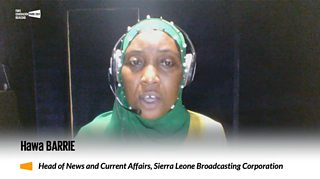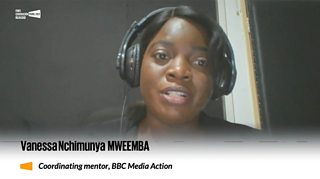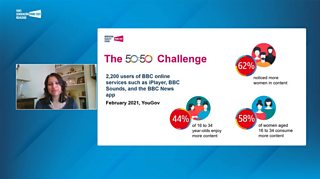Media for equality: Supporting the frontlines
Nina Goswami
±«Óãtv Creative Diversity Lead and journalist
Nina Goswami leads , which started with one goal – increasing women’s representation in media content. She recently moderated a ±«Óãtv Media Action session at the Generation Equality Forum Paris, which examined issues of gender equality in media. She shares her thoughts on the session and how 50:50 can support the frontlines.
‘Media and communication have the power to challenge stereotypes and how we see gender roles.’
Our session at the Generation Equality Forum began with these words from ±«Óãtv Media Action trustee and ±«Óãtv presenter Zeinab Badawi, in the film that kicked off our inspiring panel. This idea of challenging stereotypes and gender roles underlined our session with Hawa Barrie, head of news and current affairs at Sierra Leone Broadcasting Corporation, and Nchimunya Vanessa Mweemba, co-ordinating mentor with ±«Óãtv Media Action Zambia.

Our panellists and moderator at the Generation Equality Forum
How do we see gender roles, and how do we – as content-makers – help challenge these, and make the change?
This question is why was born. And the life experiences of Hawa and Vanessa demonstrate why it is so important that the voices we hear and see in media represent society more fully.
Through 50:50, we’re showcasing more women in areas such as science, engineering, music and sports. 50:50 puts the onus on ourselves – as content-makers – to make the change.
, from one TV team (Outside Source) monitoring their content to increase women’s representation, we now have almost 700 teams across all genres at the ±«Óãtv – including ±«Óãtv Media Action, which has been monitoring its core channels for 18 months, and will soon roll out pilots in some of its in-country programming. We also have more than using 50:50 to create change in their organisations.
At its heart, . We count the number of men and women on our programmes in almost real-time. (We count the ones we can control – excluding, for instance, some public figures). And we use that data to create change, to see if we can reach 50% women over a set period of time.

In our first 50:50 Partners’ Challenge, half of those that took part reached 50% women contributors in the content they were monitoring, compared to 31% when they started. This is a fantastic result so far and I have no doubt the partners will continue to see improvement by monitoring their content.

Why does this matter? It matters because women like Hawa and Vanessa have described the challenges in ascending in media landscapes that do not see women – particularly married women with children – as being ‘right’ to lead.
When Hawa joined SLBC more than a decade ago, the management landscape was very different. She is a trailblazer – becoming the first woman appointed as Head of News and Current Affairs at SLBC.

I asked her what allowed her to break through the ceiling at the Sierra Leone public broadcaster. She explained education, belief in her own abilities – and a supportive husband. Hawa described how access to training can be make or break for women in the media. Skills help women to be taken seriously but that development was not freely offered or open to women when she started her career. She also said: “As a woman, you need to work ten times harder than a man. It takes more than education and training to attain certain heights in the profession.”
But the landscape is changing. At SLBC, they now have women in most aspects of leadership. Hawa believes this is helping to change the conversation and how roles are seen through a gender lens.
For Hawa, the changes are only scratching the surface. She believes that across all media in Sierra Leone there needs to be a mindset change on what women can and cannot do. And she said that the training of journalists and media executives alone will not achieve gender equality and women’s empowerment in the media. This needs to be accompanied by internal media policies and self -regulation that can enable sustainable change, and national or public policies in support of gender-sensitive media.

In Zambia, it is skills development and training that drives ±«Óãtv Media Action’s Nchimunya Vanessa Mweemba. Vanessa explained how she works with local radio stations to develop public interest content and engage young audiences in all their diversity. She mentors journalists to ensure they are delivering impartial, accurate programmes that resonate with their audiences.
Vanessa describes how women still do not feature prominently in news in Zambia and that there are different sets of standards in how women in leadership positions are treated by the media.
“Women are still portrayed in a negative light. Lack of gender awareness in media makes it hard for women to feel the media can be a safe space for them to speak and be heard.”
For Vanessa that is very much where the idea of creating media for equality lies. If we are not hearing women’s voices – in front of or behind the microphone – then those radio stations may not be creating content that resonates with half their potential audience.
You can find out more about Vanessa’s work in this blog she wrote earlier this year where she talks about “the power to speak and be heard” and the gender norms that often stand in the way of women speaking out, which is often not considered socially acceptable in Zambia.
She calls for fair portrayal of women in the media, not showing them as victims, and outlined the need to train media staff to reflect all genders and their perspectives in a way that does not reinforce stereotypes.
Through mentorship, ±«Óãtv Media Actions supports FM stations in Zambia and around the world to reflect the breadth of opinion and experiences by ensuring men and women in all their diversity are heard on the issues that matter to their audiences.
The shift will take time. But I believe passionately that it is possible, because we have seen this shift at the ±«Óãtv. After three rounds of 50:50 challenges, the ±«Óãtv has seen .

For us at 50:50, the real measure of success is whether our audiences are noticing. . My favourite statistic is that 58% of women, aged 16 to 34, are consuming more ±«Óãtv online content as a result of increased women’s representation. It proves that people are .
We want to ensure the voices we hear in media – wherever you are in the world - represents society better. By increasing women contributors across all media output, we believe that – together – we can better reflect our world.
